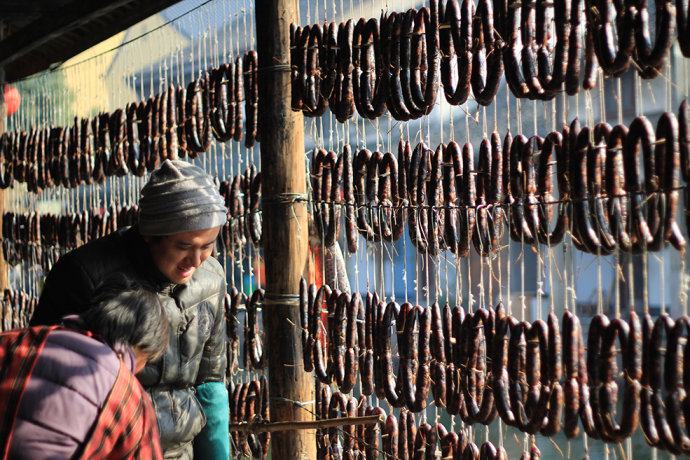They want nothing but an excuse for a party.
他们就是自己找一个理由大家一起来聚,做一些事情。
In the evening, they will together have a dinner, sing and dance.
然后晚上就会一起吃饭、跳舞、唱歌。
When Kim's parents are busy pickling vegetables, people residing 4000 km away are fascinated with another flavour in the early autumn.
当金顺姬的父母在呼兰河畔忙着腌渍各种蔬菜的同时,在4000公里之外的南国每当秋风初起,那里的人们也会被另一种时间的味道所吸引。
The different climate and geographical conditions in south China have created different cuisines and different fresh-keeping methods.
南方的天气和水土都和北方大不相同因此,南方人储存食物的方法以及他们所迷恋的滋味也和北方迥然相异。
Cured meat is popular in winter.
腊味是南方人在入冬后传统的必备美食。

The curing process was originally invented to prevent fresh meat from rotting in sultry weather.
制造腊味的初衷是为了能在南方的湿热天气里更好地储存那些容易腐败变质的新鲜肉类。
Today, the cured food appears served at a banquet.
如今,腊味既能成为家常小菜也能登大雅之堂。
Clay Pot Rice is a classic dish made with cured meat.
煲仔饭是腊味最经典的吃法之一。
It's a complicated and arduous task to cook Clay Pot Rice, which requires precise control of heat.
烹制煲仔饭是一项复杂而辛苦的工作,厨师必须严格掌握火候才能做出恰到好处的煲仔饭。
Traditional Clay Pot Rice is made in a clay pot with rice harvested 3 to 9 months earlier.
正宗的煲仔饭最好是用收获后三至九个月的半新米,还必须用瓦煲来做盛器。
Cook the rice over high heat first.
生米煮,猛火烧。
Then put the pot on a charcoal stove to ensure the juice from the meat seeps into the rice thoroughly.
煲熟后,再转到炭炉上慢慢烘,让藏在腊味里的肉汁完全渗入米饭。
The hot and sticky dish is the most proper choice in winter.
温暖香糯的煲仔饭一直是最适合冬天的美味。
Tian's family runs a cured meat shop.
阿添和家人一起经营着自家的腊味店。
Every morning, he is the one who is the busiest.
每天早上他都是店里最忙碌的人做这份工作。
Tian has been engaged in the business for 10 years and the shop, named "Hexing" has a history of 60 years.
他已经有了10年的经验和兴腊味家有着60年的历史。
Today, Tian manages the shop with his father and uncle.
如今,阿添和他的父亲、大伯一起打理照料店里的一切。












